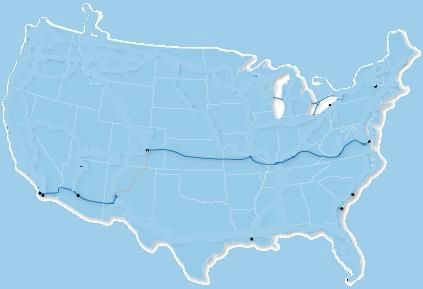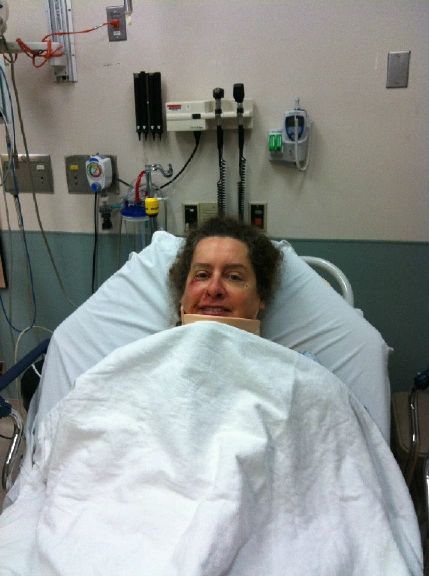Slog Across America
FAQ
Why are you doing this?
On February 20, 2011 (my 49th birthday!), I was on my third day of training for the California Triple Crown challenge (completing three 200-mile bicycle rides in one calendar year). I had finished well in the Stagecoach Century in January and the 100-mile Tour de Palm Springs on February 12. I was out for a quick, easy 70-mile ride and had done about 12 miles. Jay was recovering from a cold so he stayed home. At about 8:00 a.m., I was headed south on Harbor Island Drive where San Diego borders National City. The next thing I remember, I woke up in the back of an ambulance with an EMT trying to start an IV in the crook of my elbow. According to witnesses, my tire had slid on some wet railroad tracks (it had drizzled a bit that morning), got lodged in the gully between the metal rail and the pavement, and I was flung off my bike. I landed mainly on my right side, hitting my head so hard I lost consciousness. Two people who saw me fall carried me and my bike to the side of the road; a police officer happened by and called an ambulance. At the hospital, I was diagnosed with a Grade III concussion. Luckily, my physical injuries were fairly minor: I had some road rash on my face, arm, and knee, and my right hip was deeply bruised. The concussion symptoms lasted almost six months. Here’s how I spent some of my birthday last year:
After Jay and I got into bike touring about five years ago, I said that I wanted to ride my bike across the country the year I turned 50. Jay said we should wait until he retired at age 62 or so. As I was recovering from my injuries, Jay decided that the accident was an indicator that you shouldn't put off what you want to do, because you never know what’s going to happen. So he agreed we should plan the trip for 2012. After all, we didn't want to be like the guy in this story who had planned to ride HIS bike across the country but died when a tree branch flew through the windshield of his car and impaled him.
May 2009, we rode our bikes around Lake Michigan (1068.78 miles) in 17 days plus two rest days. We did almost no planning for that trip and survived, so I know we can do this trip. Click here to see the blog from the Great Lake Michigan Circumnavigation.
Can I come with you?
Absolutely! There are about 14 weeks left before we leave; plenty of time to train! There’s a school of thought that even unfit people will become fit in a hurry once they start biking across the country, so even if you don’t get all your training in before April 15, you can ride with us. We plan to average 65 miles a day, six days a week, so get out there and start biking.
What type of gear do you have? Answered by Jay
For those that are interested the bikes we will be using on SLAAM are:
Barbara- Surly Long Haul Trucker (LHT)
Jay- custom CoMotion Americano Co-pilot with Rohloff hub
Okay, some of you might ask why the big discrepancy on the bike quality. All I can say is for me, the bike was to be my dream bike after I retire and I just decided why wait? This is also part of the reason for doing this trip now. Who knows what the future will bring?Besides, the Surly is a very good dependable bike.
We will both have panniers front and rear.
Barbara- Jandd large mountain pannier (rear), Vaude small front panniers
Jay- Arkel GT-54 rear panniers; Axiom Lasalle front panniers
I’m still deciding on a handlebar bag. It would be mostly to carry the maps and make it easier to read them.
What bicycle adventure would be complete without a suitcase full of electronic devices?
We will each have an iPhone, which we found to be very helpful on our other bike trips. We will both have Kindles for reading and maybe even some TV watching (note from Barbara: no TV watching on MY Kindle, it’s OLD!) while hanging around camp. We both have Garmins. I have a 610 and Barbara has the 500. The 610 has map capabilities but we probably won’t use that much. They will really be just for speed/mileage functions. And of course we will have the netbook that Barbara will use to document everything for you. We will both have head lamps also. All these devices will need chargers and or batteries, so there will be those devices to carry along also.
What route are you taking?
The Adventure Cycling Association has been around since the BikeCentennial in 1976, and is the leader in bicycle touring. We will be using their pre-mapped routes of the “Southern Tier” cross-country route from Dog Beach in San Diego, California, through Arizona, then into southern New Mexico, at which point we will go into uncharted territory and head diagonally north up to Pueblo, Colorado. Once we get there, we will join the ACA “TransAm” route and stay mostly on it until we get into Virginia. We may head off this route to ride part of the Katy Trail in Missouri. Once in Virginia, we’ll use a different ACA route into Washington, D.C., to finish at the Washington Monument.

The blue line is the Adventure Cycling route and the light color line is the section we will just wing it with AAA maps and local advice.
What’s going to happen with your house while you’re gone?
Our friends Nate and Kristi are going to move in and take care of everything, including Orange Kitty aka Zeus:

They will have moved out of their house in March to travel to Thailand, then they are going to Europe after we get back.
Are you raising money for anything?
We agree that a cross-country bike trip does seem like a good opportunity to raise money and/or awareness for a cause. Jay and I both feel strongly that there should be no homeless anythings (people or pets) in the world, so we are looking into charities to support and a way to raise money that is not too obnoxious.
I could never be brave enough to do what you’re doing, but I’d like to help in some small way. As a driver, how can I make the road safer for cyclists?
What a great question; we appreciate you asking! You can be sure that, in most bike accidents, the driver of the car either did not see the cyclist or misjudged the speed of the cyclist. Jay and I routinely wear safety-yellow vests or jackets to increase our visibility. I was almost run off the road once by someone talking on a cell phone while driving. So, the first thing is “pay attention.” Even if you’re talking on a phone hands-free, your brain is distracted. And, when you do see us, let us know by turning on your lights, or, if you’re approaching the street we’re on and you’re going to make a right turn onto it, stop until we pass. If you creep up to the stop sign, that makes me think you DON’T see me and are going to turn in front of me. Which means I’m considering taking evasive action. Which kind of freaks me out.
A corollary of this is “use caution when passing a cyclist and then turning right into a street or driveway.” We are going a lot faster than you think we are. Even someone on a beach cruiser can go 12 mph (17.6 feet per second) with little effort. If you’re 20' behind me as I’m approaching a driveway you’d like to enter, please stop and wait for me to clear it. I’ll get there in a little more than a second; there’s no way you will overtake me and get through the driveway by then. You’re in a car and can easily make up the three picoseconds I just cost you! If you speed up to turn in front of me, your speed will decrease dramatically as you make the turn, which will mean I’ll have to grab the brakes and swerve to avoid slamming into you. You won’t be hurt at all, but I could end up dead. When I see that a motorist behind me is being courteous, I will give them “starfish hand” (a wave with all my fingers open) to let you know that I see you and am grateful you’re being nice.
The second thing is “don’t try to teach cyclists a lesson.” Okay, maybe we coast through most stop signs. And I know some racers treat red lights like yellow lights. That’s irritating! But most of us are just trying to get some exercise, get from Point A to Point B, or get to work. We know you could completely cream us and, most likely, not be prosecuted for anything. So please don’t buzz us with your side mirror as you pass - if there’s no oncoming traffic, you can shade into the other lane a bit to give us a wide berth. We appreciate that! Your brain wants to steer the car toward what your eyes are looking at, so once you notice us, put your eyes back on the road and just drive past us. Don’t pass us and then swerve into the bike line as a reminder that you could have done that 100 yards back. We know you hold all the cards. Please be nice.
 After Jay and I got into bike touring about five years ago, I said that I wanted to ride my bike across the country the year I turned 50. Jay said we should wait until he retired at age 62 or so. As I was recovering from my injuries, Jay decided that the accident was an indicator that you shouldn't put off what you want to do, because you never know what’s going to happen. So he agreed we should plan the trip for 2012. After all, we didn't want to be like the guy in
After Jay and I got into bike touring about five years ago, I said that I wanted to ride my bike across the country the year I turned 50. Jay said we should wait until he retired at age 62 or so. As I was recovering from my injuries, Jay decided that the accident was an indicator that you shouldn't put off what you want to do, because you never know what’s going to happen. So he agreed we should plan the trip for 2012. After all, we didn't want to be like the guy in 

